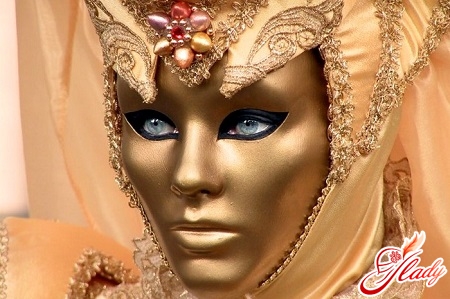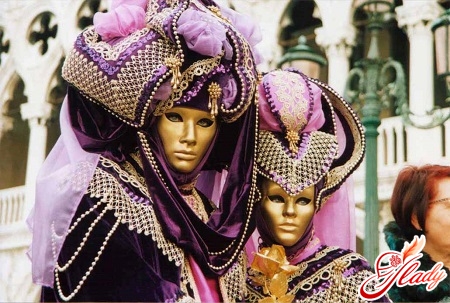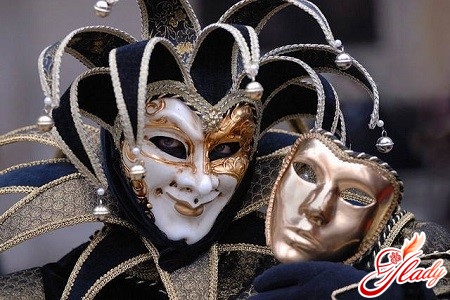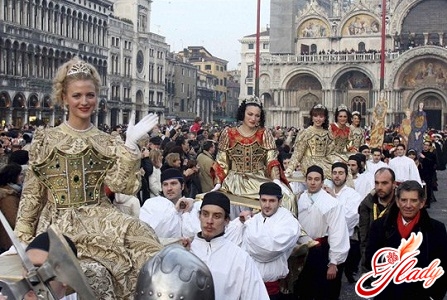 Venetian carnival is a time for fun,insane luxury and extravagance. Beautiful ladies dancing in the streets, and gallant cavaliers, losing the whole fortunes under the roofs of gambling houses - all this is about him! It seems that the very soul of the ancient city comes to life on the water, filling everything around with the spirit of a magical extravaganza. The mere mention of the carnival passing in Venice paints thoughts with the riot of colors and sounds. The holiday erases the fine line between ordinary reality and a fantastic mystery, making possible the harmonious neighborhood of different eras, hiding behind the masks racial and social differences, immerses each participant in the atmosphere of the miracle that has come true. Nights, permeated with the mysterious light of street lamps, candles and fireworks, become a time of reckless love affairs and easy flirting. Annually before the Great Lent around the world a wave of carnivals is rolling: France, Switzerland, Santa Cruz, Rio de Janeiro. You can drive through European cities, then plunge into fun with foolish dances and beer in Cologne, then falling under the hail of orange "shells" in Ivrea, then becoming a witness of the funeral funeral cardboard Sardine in Tenerife. But none of these holidays can be compared in its delicious refinement, in scope, in antiquity and popularity with the carnivals in Venice. No matter how hard the people of other countries try to reproduce something similar in their homeland, inventing interesting processions, parades and all kinds of entertainment, the originality of Venice remains unattainable and inviting. Ten days in the streets, squares, canals and bridges of this unique city unfolds a mesmerizing performance - carnival masks!
Venetian carnival is a time for fun,insane luxury and extravagance. Beautiful ladies dancing in the streets, and gallant cavaliers, losing the whole fortunes under the roofs of gambling houses - all this is about him! It seems that the very soul of the ancient city comes to life on the water, filling everything around with the spirit of a magical extravaganza. The mere mention of the carnival passing in Venice paints thoughts with the riot of colors and sounds. The holiday erases the fine line between ordinary reality and a fantastic mystery, making possible the harmonious neighborhood of different eras, hiding behind the masks racial and social differences, immerses each participant in the atmosphere of the miracle that has come true. Nights, permeated with the mysterious light of street lamps, candles and fireworks, become a time of reckless love affairs and easy flirting. Annually before the Great Lent around the world a wave of carnivals is rolling: France, Switzerland, Santa Cruz, Rio de Janeiro. You can drive through European cities, then plunge into fun with foolish dances and beer in Cologne, then falling under the hail of orange "shells" in Ivrea, then becoming a witness of the funeral funeral cardboard Sardine in Tenerife. But none of these holidays can be compared in its delicious refinement, in scope, in antiquity and popularity with the carnivals in Venice. No matter how hard the people of other countries try to reproduce something similar in their homeland, inventing interesting processions, parades and all kinds of entertainment, the originality of Venice remains unattainable and inviting. Ten days in the streets, squares, canals and bridges of this unique city unfolds a mesmerizing performance - carnival masks! 
From the history of the carnival
The first mention of such a festival go awaytheir roots in times of paganism. Yes, and the very word "carnival", as history shows, came from the Latin "carrus navalis" - the name of the cart, on which idols of fertility were still transported in the Bronze Age. The prototype of the modern holiday is considered to be the ancient Saturnalia - celebrations dedicated to the god of fertility and the harvest of Saturn. In those days, the Romans revived the "golden age" of universal equality. The boundaries between slaves and free citizens were blurred, and the gentlemen ate at the same table as the niello. It should be noted that pagan holidays rarely went without sacrifices. Thus, in the carnival of Venice in ancient times, there was a barbaric custom. Its essence boiled down to the fact that during the whole period of celebrations a false king was elected who, at the end of the Saturnalia, either had to commit suicide or die at the stake or a knife. Such were the popular "entertainments" in times of pagan worship of the gods. With the beginning of Christianity, Saturnalia was banned, but the idea of reincarnation, equalizing all the participants, survived the century and revived in European carnivals. And there is nothing surprising in the fact that it is Italy, whose inhabitants are known for their cheerful disposition and irrepressible craving for the holidays, has become the birthplace of such popular celebrations. Now it is difficult to say which version of the time of the first carnival in Venice is true: history does not give an exact answer to this question. But the earliest documentary mention dates back to the eleventh century. For certain it is known that in the thirteenth century the last day before Lent was declared in this Italian city the day of folk festivities. All of its population, dressed in masks and costumes, flocked to the St. Mark's Square to participate in the general merriment and dances. In the XVIII century, the Venetian carnival reached its highest peak. The heady atmosphere of permissiveness, the spirit of flirting and betrayal, the anticipation of unforgettable adventures attracted aristocrats from all over Europe. And even the august persons and princes of the blood did not consider it inconspicuous to appear on the streets and take part in the merriment. For the period of carnivals in Venice, the city itself became a temple of masks, they were not only celebrated, but also engaged in ordinary affairs. Residents, hiding their faces behind the multicolored overlays, went for shopping and for service. The mask erased all norms of behavior and morality, giving a sense of freedom and permissiveness. In the XVIII century, the heroes of the Italian comedy del arte became the main characters of the carnival held in Venice - thousands of Harlequins, Pantalone, Pierrot appeared on the streets. It was then that the holiday found its emblem. She became Colombina. Simultaneously with this significant event a tradition appeared that has survived to this day: to launch a paper pigeon - Colombine - from the bell tower of San Marco. It explodes over the square, showering confetti with rain, and thus opens up the Venetian carnival. It is sad, but even so popular among the nobility, as well as among ordinary citizens, the festivities did not avoid oblivion. The fall of the Republic and the revolutionary moods of the late 18th century led to the fact that the cheerful spirit of Venice - the carnival - was almost extinguished. In the 20 years of the last century, Benito Mussolini officially banned its conduct. But the history of these tremendous festivities, fortunately, did not end in such a sad way. And like any fairy tale that has a happy ending, like a Phoenix bird, reborn from the ashes, the Venetian carnival has acquired a "second wind". In 1979, thanks to Federico Fellini and with the permission of the Pope, the paper pigeon again flew over the Piazza San Marco, and the festival once again poured into the streets of the ancient city, arousing hope in people and giving joy. In 1996, the famous couturier Pierre Cardin wrote a hymn for the then-passing carnival in Venice. A special feature of the festival was the annual selection of new themes, the preservation of the traditions of the past and their harmonious combination with the spirit of modernity. 
The march is a tribute to beauty and courage
Carnival in Venice officially opened by descent"Angel" with a hundred-meter bell tower in St. Mark's Square. A holiday with colorful snow from confetti falls on the city. Gomon, laughter, music, sounding everywhere, form a cacophony of cheerful sounds. Multilingual crowd in a single rush marches through St. Mark's Square, recreating the story of the abduction of twelve girls by pirates from Istria and their salvation by brave citizens. This is the notorious Mari parade - a tradition that has come down to us from the depths of centuries and has become an integral part of the carnival held in Venice. The prehistory of this action, according to the citizens, is based on real events. In the distant 943 in Venice, a special date was provided for the conduct of marriages. It was on February 2, the day of the Meeting of Mary, that wedding corteges with twelve brides swam along the channel of "virgins", heading to the church of St. Nicholas. It was there that the girls were supposed to meet the grooms. But such a joyous event was darkened by the attack of pirates who kidnapped brides along with the dowry. Enraged Venetians began to pursue the sea robbers and in the battle with them released their beautiful compatriots. According to one source, ever since, by the decision of the government, twelve of the poorest girls in Venice, named Mary, have been married to the means of local rich people every year. Affluent families allocated money for the acquisition of a dowry and the organization of the celebration. Although, according to other sources, Maria's unmarried daughters married the sons of the local bourgeoisie on that day. Third sources claim that to perpetuate the heroism of brave Venetians, a kind of beauty contest with the participation of twelve girls, two from each district of the city, was simply arranged. True, he wore more religious character, since the beauties had to be present at all the divine services of the city. The girls were called Mariami, dressed up in luxurious clothes and did not spare jewelry. All three legends are one in one: the costs of organizing mass celebrations fell heavily on the shoulders of the rich nobility. So gradually the number of beauties was reduced to three, and then the living girls were replaced with wooden dolls, which caused protests among the people. Now this tradition, which has been covered with legends and traditions, has turned into a kind of theatrical procession, without which the annual carnival held in Venice is not without it. On the first Saturday, falling out on holidays, twelve young Venetian women, accompanied by extras in historical costumes and musicians, gather near the church of St. Peter (San Pietro di Castello) and go to St. Mark's Square. It is here the next day and the most beautiful Venetian is determined. The girl, for whom such an honorable choice fell, receives a valuable prize.
Features of the carnival these days
The carnival held in Venice in 2011 wasis devoted to the beautiful half of humanity, since the completion of it coincided with the Eighth March - the International Women's Day. The fantasy of the organizers truly knew no bounds and turned the holiday into a romantic ode in honor of the fairer sex. Those who were fortunate enough to be present in Venice at that time, are enthusiastically sharing their impressions. Attention is paid to outfits. The costumes had to correspond to the heroes of the post-romantic era, led by Elizabeth of Bavaria, and the traditional clothes of the Middle Ages were replaced by crinolines, corsets, fans and frock coats. Carnival in 2012 was held under the motto "Life is theater, put on masks!". Agree, this is very symbolic. For ten days, dedicated to traditional celebrations, the ancient city on the water personified the capital of European theatrical art. The opening of the celebration began with the procession of Marius, the speech of the mayor and a beautiful performance, when the girl came down from the bell tower in the image of the Angel. Since the theater was organized by the theme of the carnival organized in Venice, many guests of the holiday had many opportunities to see colorful performances and shows. This is the traditional comedy del arte, and the Balkan music festival, and a parade of carnival costumes and many other interesting and colorful events. Particular attention deserves a party on the sixteenth of February. On this day, closer to noon, several original performances took place in the San Marco square at the same time. And at night, according to organizers and participants of the carnival held in Venice, the city plunged into the atmosphere of old traditions of the holiday. We can say that for the whole ten days the ancient Italian city suddenly turned into a huge theatrical stage for a large-scale production of the director-wizard. There were roles for both participants and viewers, so success exceeded all expectations. As for 2013, the traditional carnival in Venice was held under the motto "Live in color" and its main themes were two water elements - water and fire. Perhaps, not for nothing on the opening day of the city covered with rain? Probably, nature itself blessed the holiday in such a "wet" way. In addition, the theme of flowers, chosen for the carnival, is also relevant for the reason that Venice has become the "cradle" of painting. They worked on their immortal masterpieces Canaletto and Guardi, Belotto and Titian, Giorgione and Veronese. Each day of the festivities was dedicated to a new color. Spectators could see three flights from the bell tower on St. Mark's Square: the traditional indulgence of the Angel, and the descent of the Eagle and the Lion. All other events, including circus performances, regatta through the canals of Venice, exhibitions of paintings, masks competitions, costumed processions and concerts, one way or another, but were related to the main theme. 
Do not be afraid to try on the mask!
Recently, a powerful spirit of unity and freedomalready ceased to hang over the carnival in the ancient city: people were divided into participants and spectators. The atmosphere of mystery has disappeared, mystery has faded and even the general unrestrained fun does not bring the former satisfaction. The modern Venetian carnival gradually loses its original meaning and turns into a purely tourist event. The sense of nationality and community is lost, because the division into spectators and performers destroys the long-standing harmony of the holiday. And now its essence is the theatrical processions, where masks, unfortunately, are less and less, and flashes of cameras and ordinary curious townsfolk increasingly. Indeed, the average European tourists, who come to the carnival, prefer to stay away from participation in it and choose for themselves the position of the observer for the grotesque action. But it's so easy to succumb to the mood of gay Venetians, to acquire a mask unconceivable in design and brightness, to try on an unusual suit and merge into a passing procession! It is the direct participation that will help to feel the real free spirit of the holiday, to feel the time frame parting in an instant, and the breath of the ancient events touches the cheek for a moment. After all, it's not a merry mood and waiting for miracles and shows. It is important to capture a special attitude, liberty, community with masks, utopianism and experience unity with the eternal and beautiful, realizing suddenly that the past, the present and the future are inseparable. So do not be afraid to try on the mask! True, the choice of this carnival symbol and the corresponding costume will entail considerable costs, because traditional dresses have very good quality. They are shed from brocade or velvet and are often decorated with natural fur. But is it possible to compare the money spent with those emotions that are ineffable in terms of brightness and strength, which fall upon a person as soon as he becomes "his" among masks? The world changes, if you look at it through the mysterious slits for your eyes, hiding your true essence behind the grotesque mask. By the way, participation in the annual carnival decorating Venice provides for strict observance of the rules. Without them, the costume action loses its secret. Therefore, dressing in an outfit, do not talk, but communicate with others with the help of gestures. Acquaintance consists in presenting business cards. And do not forget to have a bite, because in the mask you will hardly be able to pamper yourself with a glass of wine or traditional donuts. But any holiday, even the most beautiful, is coming to an end. Bright fireworks danced brightly, the participants reluctantly remove the grotesque masks from tired faces, gradually merging with the crowd of spectators ... And now a straw effigy flames with flames, illuminating St. Mark's Square, and ghostly-fragile Venice, like an eternally young dancer, frozen in an unthinkable pas , reflected in the mirror rim of the water in anticipation of a new carnival ...









